Public Health Nutrition Policy Implementation in Australia: An Essay
VerifiedAdded on 2022/08/08
|8
|1659
|16
Essay
AI Summary
This essay examines the implementation of public health nutrition policies in Australia, with a specific focus on food fortification, particularly the addition of iodine. It begins by introducing the importance of nutrition and the role of government policies, such as the Food Standards Australia New Zealand (FSANZ) policy, in promoting public health. The essay highlights the need for nutrition interventions to address micronutrient deficiencies, such as those of iodine, iron, and vitamins. It then delves into the details of the FSANZ policy, outlining its functions, including standard-setting and application. The essay discusses the mandatory fortification standards, including the addition of thiamine and folic acid to wheat flour and iodized salt to bread, and the benefits of bread as a vehicle for iodine. It also explores the risk factors associated with micronutrient deficiencies, such as low intake of essential nutrients and bioavailability issues. The conclusion emphasizes the positive impact of these policies on public health outcomes, such as improved iodine levels and reduced neural tube defects.
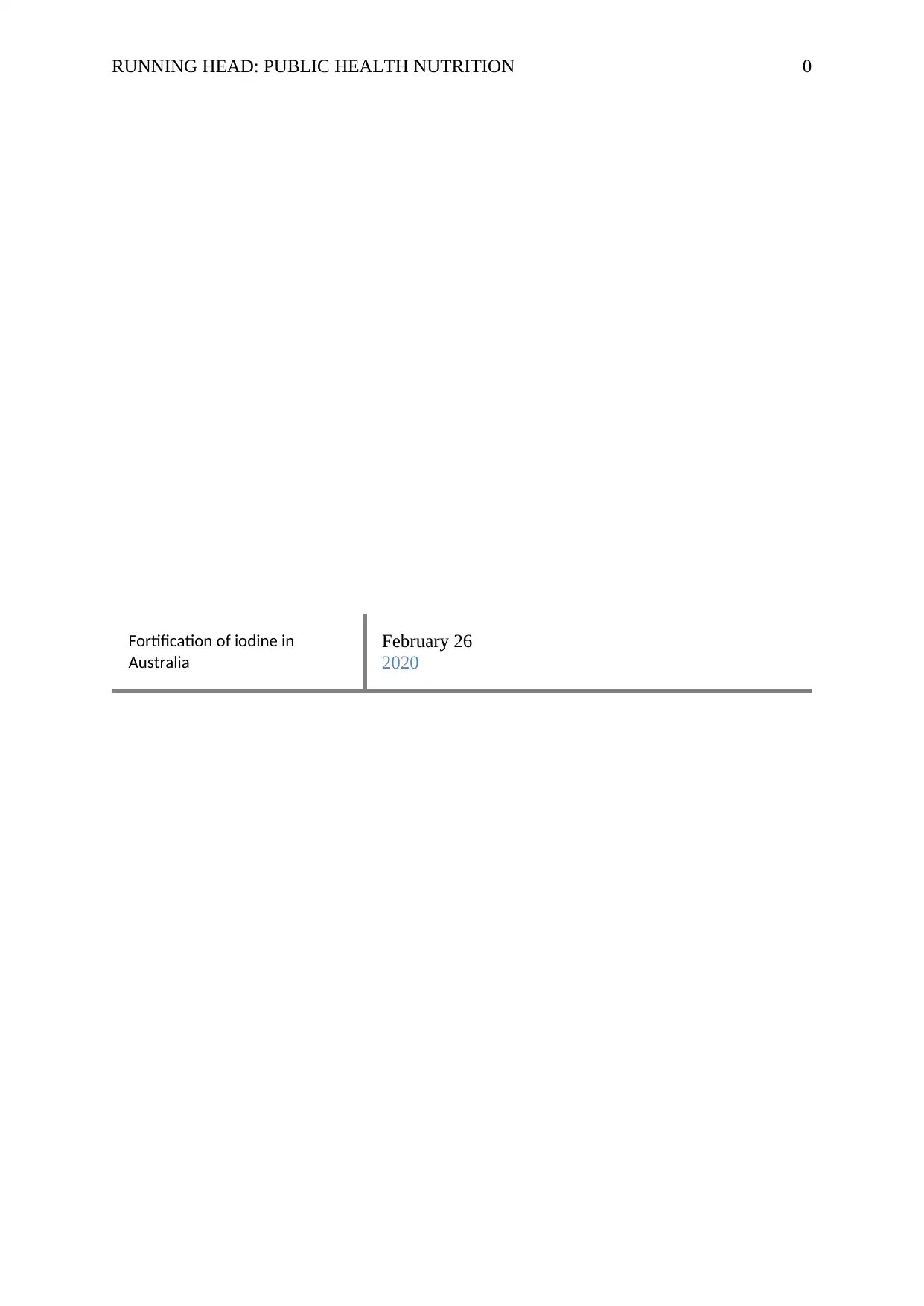
RUNNING HEAD: PUBLIC HEALTH NUTRITION 0
Fortification of iodine in
Australia
February 26
2020
Fortification of iodine in
Australia
February 26
2020
Paraphrase This Document
Need a fresh take? Get an instant paraphrase of this document with our AI Paraphraser
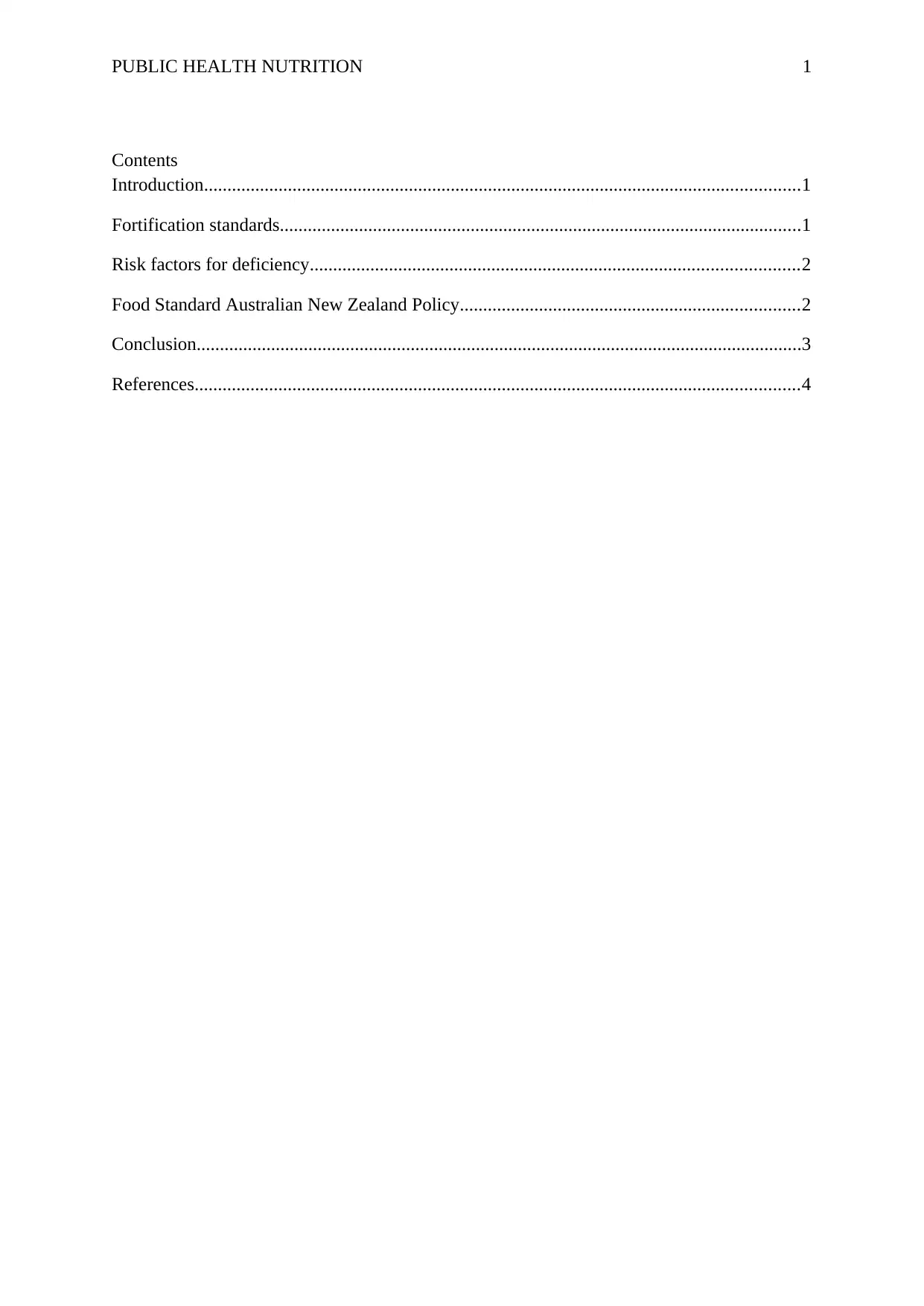
PUBLIC HEALTH NUTRITION 1
Contents
Introduction................................................................................................................................1
Fortification standards................................................................................................................1
Risk factors for deficiency.........................................................................................................2
Food Standard Australian New Zealand Policy.........................................................................2
Conclusion..................................................................................................................................3
References..................................................................................................................................4
Contents
Introduction................................................................................................................................1
Fortification standards................................................................................................................1
Risk factors for deficiency.........................................................................................................2
Food Standard Australian New Zealand Policy.........................................................................2
Conclusion..................................................................................................................................3
References..................................................................................................................................4
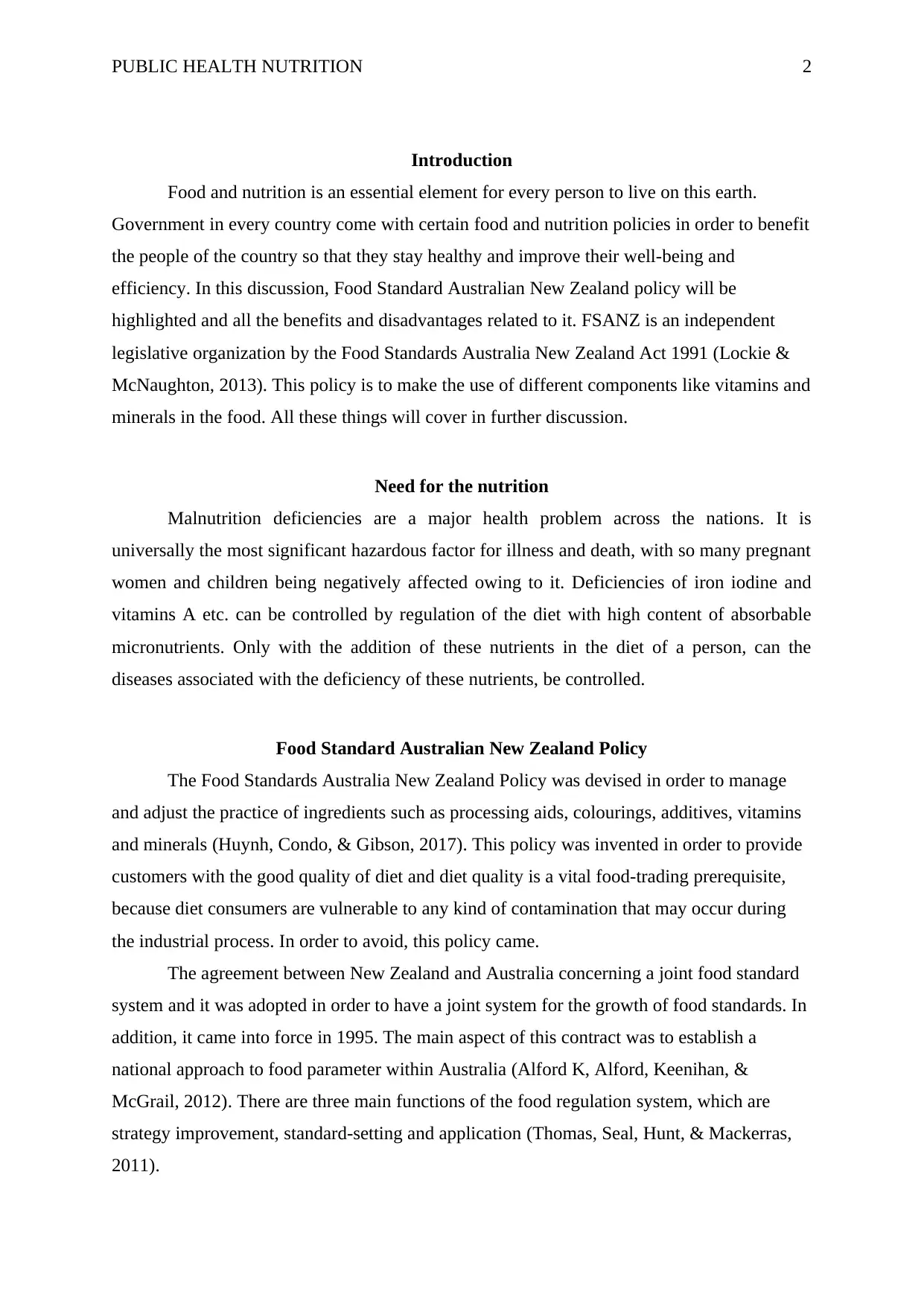
PUBLIC HEALTH NUTRITION 2
Introduction
Food and nutrition is an essential element for every person to live on this earth.
Government in every country come with certain food and nutrition policies in order to benefit
the people of the country so that they stay healthy and improve their well-being and
efficiency. In this discussion, Food Standard Australian New Zealand policy will be
highlighted and all the benefits and disadvantages related to it. FSANZ is an independent
legislative organization by the Food Standards Australia New Zealand Act 1991 (Lockie &
McNaughton, 2013). This policy is to make the use of different components like vitamins and
minerals in the food. All these things will cover in further discussion.
Need for the nutrition
Malnutrition deficiencies are a major health problem across the nations. It is
universally the most significant hazardous factor for illness and death, with so many pregnant
women and children being negatively affected owing to it. Deficiencies of iron iodine and
vitamins A etc. can be controlled by regulation of the diet with high content of absorbable
micronutrients. Only with the addition of these nutrients in the diet of a person, can the
diseases associated with the deficiency of these nutrients, be controlled.
Food Standard Australian New Zealand Policy
The Food Standards Australia New Zealand Policy was devised in order to manage
and adjust the practice of ingredients such as processing aids, colourings, additives, vitamins
and minerals (Huynh, Condo, & Gibson, 2017). This policy was invented in order to provide
customers with the good quality of diet and diet quality is a vital food-trading prerequisite,
because diet consumers are vulnerable to any kind of contamination that may occur during
the industrial process. In order to avoid, this policy came.
The agreement between New Zealand and Australia concerning a joint food standard
system and it was adopted in order to have a joint system for the growth of food standards. In
addition, it came into force in 1995. The main aspect of this contract was to establish a
national approach to food parameter within Australia (Alford K, Alford, Keenihan, &
McGrail, 2012). There are three main functions of the food regulation system, which are
strategy improvement, standard-setting and application (Thomas, Seal, Hunt, & Mackerras,
2011).
Introduction
Food and nutrition is an essential element for every person to live on this earth.
Government in every country come with certain food and nutrition policies in order to benefit
the people of the country so that they stay healthy and improve their well-being and
efficiency. In this discussion, Food Standard Australian New Zealand policy will be
highlighted and all the benefits and disadvantages related to it. FSANZ is an independent
legislative organization by the Food Standards Australia New Zealand Act 1991 (Lockie &
McNaughton, 2013). This policy is to make the use of different components like vitamins and
minerals in the food. All these things will cover in further discussion.
Need for the nutrition
Malnutrition deficiencies are a major health problem across the nations. It is
universally the most significant hazardous factor for illness and death, with so many pregnant
women and children being negatively affected owing to it. Deficiencies of iron iodine and
vitamins A etc. can be controlled by regulation of the diet with high content of absorbable
micronutrients. Only with the addition of these nutrients in the diet of a person, can the
diseases associated with the deficiency of these nutrients, be controlled.
Food Standard Australian New Zealand Policy
The Food Standards Australia New Zealand Policy was devised in order to manage
and adjust the practice of ingredients such as processing aids, colourings, additives, vitamins
and minerals (Huynh, Condo, & Gibson, 2017). This policy was invented in order to provide
customers with the good quality of diet and diet quality is a vital food-trading prerequisite,
because diet consumers are vulnerable to any kind of contamination that may occur during
the industrial process. In order to avoid, this policy came.
The agreement between New Zealand and Australia concerning a joint food standard
system and it was adopted in order to have a joint system for the growth of food standards. In
addition, it came into force in 1995. The main aspect of this contract was to establish a
national approach to food parameter within Australia (Alford K, Alford, Keenihan, &
McGrail, 2012). There are three main functions of the food regulation system, which are
strategy improvement, standard-setting and application (Thomas, Seal, Hunt, & Mackerras,
2011).
⊘ This is a preview!⊘
Do you want full access?
Subscribe today to unlock all pages.

Trusted by 1+ million students worldwide
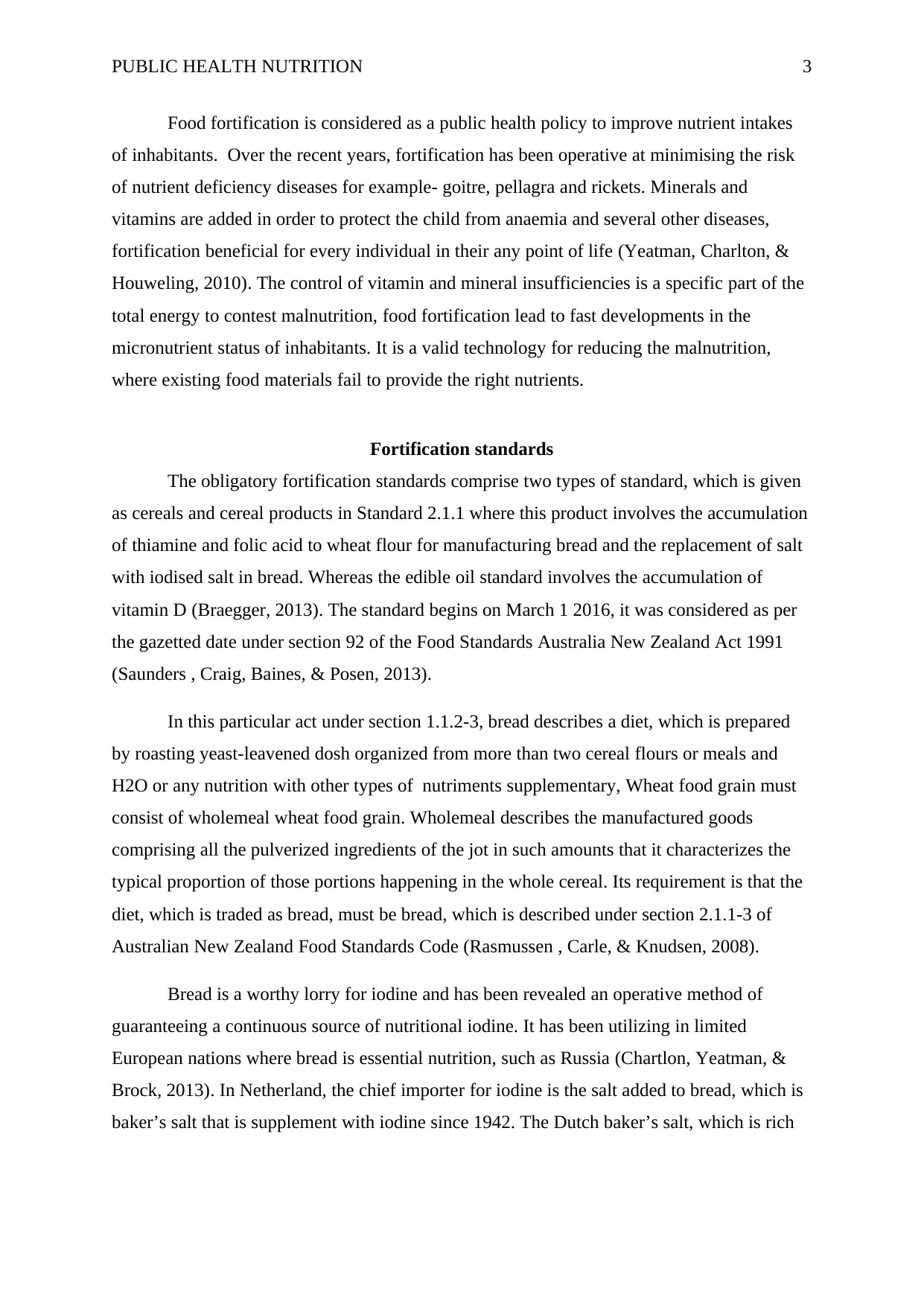
PUBLIC HEALTH NUTRITION 3
Food fortification is considered as a public health policy to improve nutrient intakes
of inhabitants. Over the recent years, fortification has been operative at minimising the risk
of nutrient deficiency diseases for example- goitre, pellagra and rickets. Minerals and
vitamins are added in order to protect the child from anaemia and several other diseases,
fortification beneficial for every individual in their any point of life (Yeatman, Charlton, &
Houweling, 2010). The control of vitamin and mineral insufficiencies is a specific part of the
total energy to contest malnutrition, food fortification lead to fast developments in the
micronutrient status of inhabitants. It is a valid technology for reducing the malnutrition,
where existing food materials fail to provide the right nutrients.
Fortification standards
The obligatory fortification standards comprise two types of standard, which is given
as cereals and cereal products in Standard 2.1.1 where this product involves the accumulation
of thiamine and folic acid to wheat flour for manufacturing bread and the replacement of salt
with iodised salt in bread. Whereas the edible oil standard involves the accumulation of
vitamin D (Braegger, 2013). The standard begins on March 1 2016, it was considered as per
the gazetted date under section 92 of the Food Standards Australia New Zealand Act 1991
(Saunders , Craig, Baines, & Posen, 2013).
In this particular act under section 1.1.2-3, bread describes a diet, which is prepared
by roasting yeast-leavened dosh organized from more than two cereal flours or meals and
H2O or any nutrition with other types of nutriments supplementary, Wheat food grain must
consist of wholemeal wheat food grain. Wholemeal describes the manufactured goods
comprising all the pulverized ingredients of the jot in such amounts that it characterizes the
typical proportion of those portions happening in the whole cereal. Its requirement is that the
diet, which is traded as bread, must be bread, which is described under section 2.1.1-3 of
Australian New Zealand Food Standards Code (Rasmussen , Carle, & Knudsen, 2008).
Bread is a worthy lorry for iodine and has been revealed an operative method of
guaranteeing a continuous source of nutritional iodine. It has been utilizing in limited
European nations where bread is essential nutrition, such as Russia (Chartlon, Yeatman, &
Brock, 2013). In Netherland, the chief importer for iodine is the salt added to bread, which is
baker’s salt that is supplement with iodine since 1942. The Dutch baker’s salt, which is rich
Food fortification is considered as a public health policy to improve nutrient intakes
of inhabitants. Over the recent years, fortification has been operative at minimising the risk
of nutrient deficiency diseases for example- goitre, pellagra and rickets. Minerals and
vitamins are added in order to protect the child from anaemia and several other diseases,
fortification beneficial for every individual in their any point of life (Yeatman, Charlton, &
Houweling, 2010). The control of vitamin and mineral insufficiencies is a specific part of the
total energy to contest malnutrition, food fortification lead to fast developments in the
micronutrient status of inhabitants. It is a valid technology for reducing the malnutrition,
where existing food materials fail to provide the right nutrients.
Fortification standards
The obligatory fortification standards comprise two types of standard, which is given
as cereals and cereal products in Standard 2.1.1 where this product involves the accumulation
of thiamine and folic acid to wheat flour for manufacturing bread and the replacement of salt
with iodised salt in bread. Whereas the edible oil standard involves the accumulation of
vitamin D (Braegger, 2013). The standard begins on March 1 2016, it was considered as per
the gazetted date under section 92 of the Food Standards Australia New Zealand Act 1991
(Saunders , Craig, Baines, & Posen, 2013).
In this particular act under section 1.1.2-3, bread describes a diet, which is prepared
by roasting yeast-leavened dosh organized from more than two cereal flours or meals and
H2O or any nutrition with other types of nutriments supplementary, Wheat food grain must
consist of wholemeal wheat food grain. Wholemeal describes the manufactured goods
comprising all the pulverized ingredients of the jot in such amounts that it characterizes the
typical proportion of those portions happening in the whole cereal. Its requirement is that the
diet, which is traded as bread, must be bread, which is described under section 2.1.1-3 of
Australian New Zealand Food Standards Code (Rasmussen , Carle, & Knudsen, 2008).
Bread is a worthy lorry for iodine and has been revealed an operative method of
guaranteeing a continuous source of nutritional iodine. It has been utilizing in limited
European nations where bread is essential nutrition, such as Russia (Chartlon, Yeatman, &
Brock, 2013). In Netherland, the chief importer for iodine is the salt added to bread, which is
baker’s salt that is supplement with iodine since 1942. The Dutch baker’s salt, which is rich
Paraphrase This Document
Need a fresh take? Get an instant paraphrase of this document with our AI Paraphraser
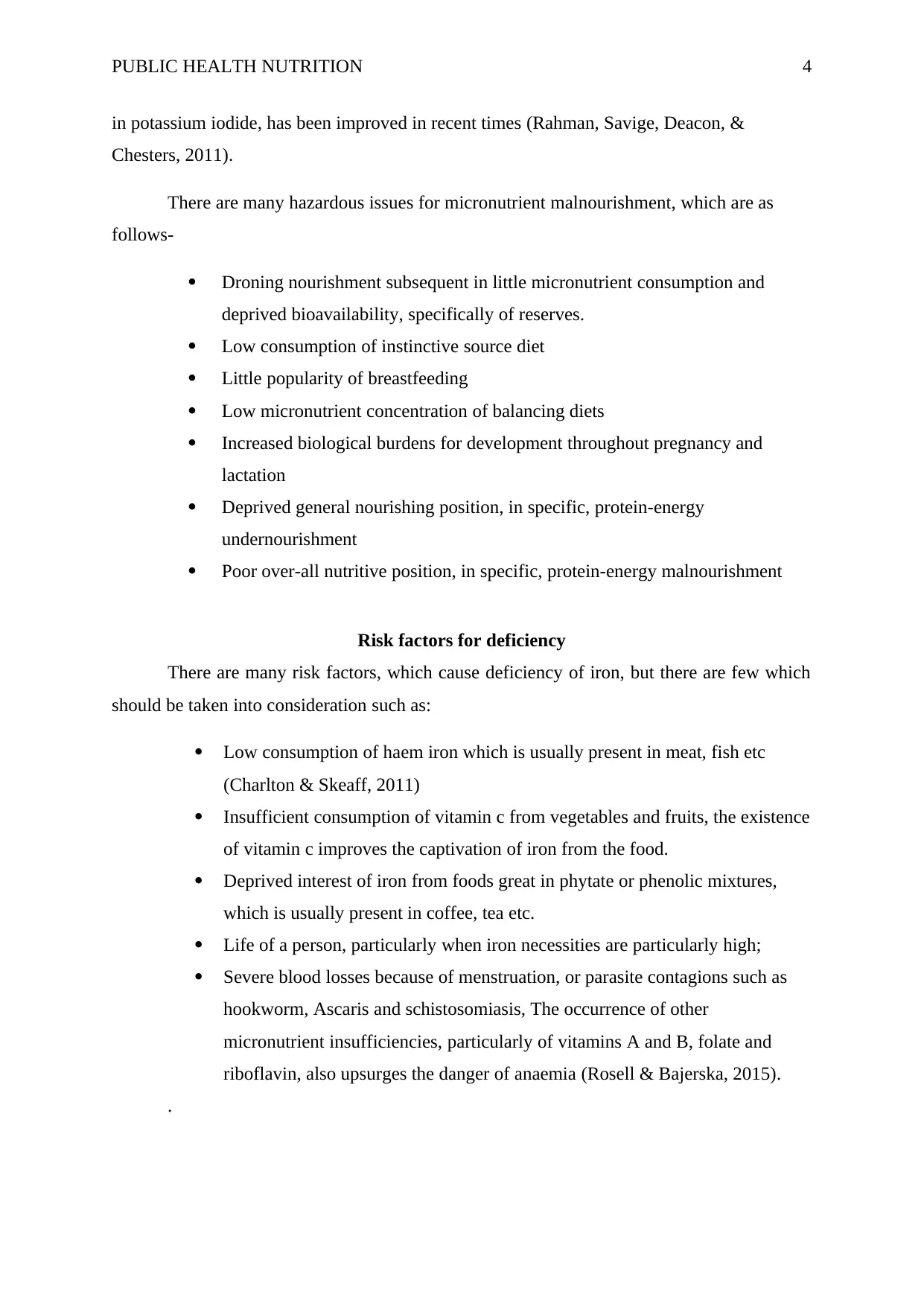
PUBLIC HEALTH NUTRITION 4
in potassium iodide, has been improved in recent times (Rahman, Savige, Deacon, &
Chesters, 2011).
There are many hazardous issues for micronutrient malnourishment, which are as
follows-
Droning nourishment subsequent in little micronutrient consumption and
deprived bioavailability, specifically of reserves.
Low consumption of instinctive source diet
Little popularity of breastfeeding
Low micronutrient concentration of balancing diets
Increased biological burdens for development throughout pregnancy and
lactation
Deprived general nourishing position, in specific, protein-energy
undernourishment
Poor over-all nutritive position, in specific, protein-energy malnourishment
Risk factors for deficiency
There are many risk factors, which cause deficiency of iron, but there are few which
should be taken into consideration such as:
Low consumption of haem iron which is usually present in meat, fish etc
(Charlton & Skeaff, 2011)
Insufficient consumption of vitamin c from vegetables and fruits, the existence
of vitamin c improves the captivation of iron from the food.
Deprived interest of iron from foods great in phytate or phenolic mixtures,
which is usually present in coffee, tea etc.
Life of a person, particularly when iron necessities are particularly high;
Severe blood losses because of menstruation, or parasite contagions such as
hookworm, Ascaris and schistosomiasis, The occurrence of other
micronutrient insufficiencies, particularly of vitamins A and B, folate and
riboflavin, also upsurges the danger of anaemia (Rosell & Bajerska, 2015).
.
in potassium iodide, has been improved in recent times (Rahman, Savige, Deacon, &
Chesters, 2011).
There are many hazardous issues for micronutrient malnourishment, which are as
follows-
Droning nourishment subsequent in little micronutrient consumption and
deprived bioavailability, specifically of reserves.
Low consumption of instinctive source diet
Little popularity of breastfeeding
Low micronutrient concentration of balancing diets
Increased biological burdens for development throughout pregnancy and
lactation
Deprived general nourishing position, in specific, protein-energy
undernourishment
Poor over-all nutritive position, in specific, protein-energy malnourishment
Risk factors for deficiency
There are many risk factors, which cause deficiency of iron, but there are few which
should be taken into consideration such as:
Low consumption of haem iron which is usually present in meat, fish etc
(Charlton & Skeaff, 2011)
Insufficient consumption of vitamin c from vegetables and fruits, the existence
of vitamin c improves the captivation of iron from the food.
Deprived interest of iron from foods great in phytate or phenolic mixtures,
which is usually present in coffee, tea etc.
Life of a person, particularly when iron necessities are particularly high;
Severe blood losses because of menstruation, or parasite contagions such as
hookworm, Ascaris and schistosomiasis, The occurrence of other
micronutrient insufficiencies, particularly of vitamins A and B, folate and
riboflavin, also upsurges the danger of anaemia (Rosell & Bajerska, 2015).
.
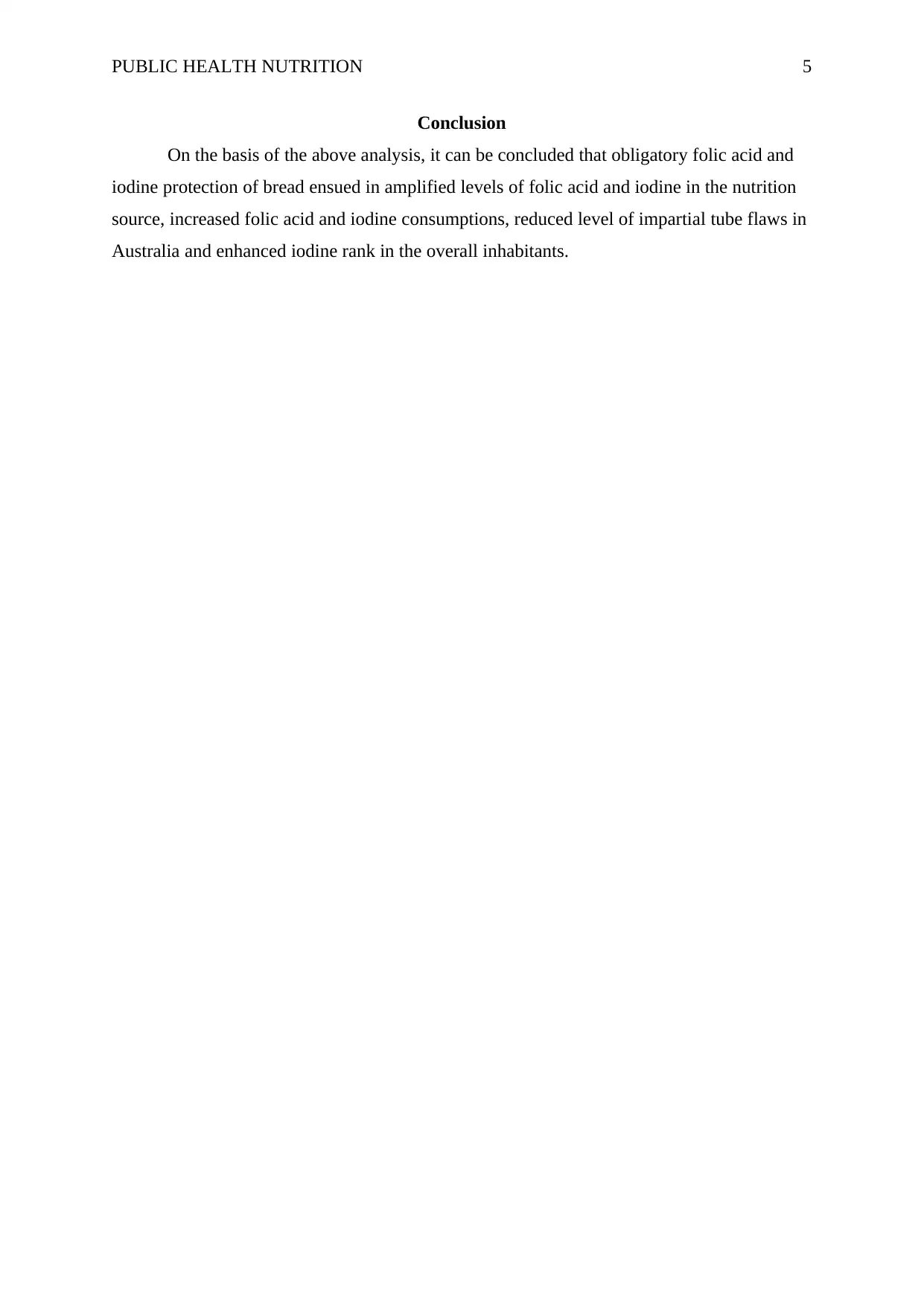
PUBLIC HEALTH NUTRITION 5
Conclusion
On the basis of the above analysis, it can be concluded that obligatory folic acid and
iodine protection of bread ensued in amplified levels of folic acid and iodine in the nutrition
source, increased folic acid and iodine consumptions, reduced level of impartial tube flaws in
Australia and enhanced iodine rank in the overall inhabitants.
Conclusion
On the basis of the above analysis, it can be concluded that obligatory folic acid and
iodine protection of bread ensued in amplified levels of folic acid and iodine in the nutrition
source, increased folic acid and iodine consumptions, reduced level of impartial tube flaws in
Australia and enhanced iodine rank in the overall inhabitants.
⊘ This is a preview!⊘
Do you want full access?
Subscribe today to unlock all pages.

Trusted by 1+ million students worldwide
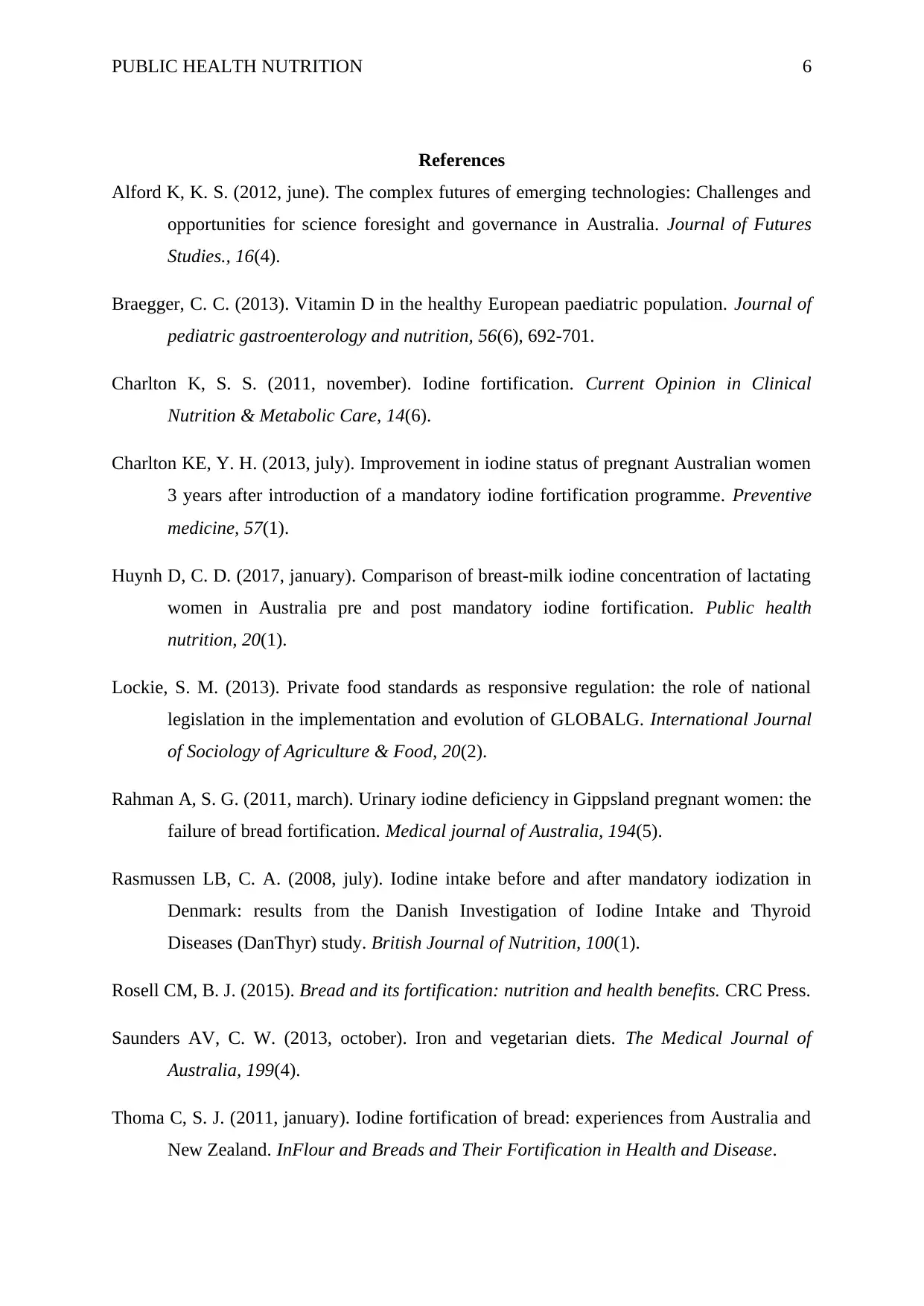
PUBLIC HEALTH NUTRITION 6
References
Alford K, K. S. (2012, june). The complex futures of emerging technologies: Challenges and
opportunities for science foresight and governance in Australia. Journal of Futures
Studies., 16(4).
Braegger, C. C. (2013). Vitamin D in the healthy European paediatric population. Journal of
pediatric gastroenterology and nutrition, 56(6), 692-701.
Charlton K, S. S. (2011, november). Iodine fortification. Current Opinion in Clinical
Nutrition & Metabolic Care, 14(6).
Charlton KE, Y. H. (2013, july). Improvement in iodine status of pregnant Australian women
3 years after introduction of a mandatory iodine fortification programme. Preventive
medicine, 57(1).
Huynh D, C. D. (2017, january). Comparison of breast-milk iodine concentration of lactating
women in Australia pre and post mandatory iodine fortification. Public health
nutrition, 20(1).
Lockie, S. M. (2013). Private food standards as responsive regulation: the role of national
legislation in the implementation and evolution of GLOBALG. International Journal
of Sociology of Agriculture & Food, 20(2).
Rahman A, S. G. (2011, march). Urinary iodine deficiency in Gippsland pregnant women: the
failure of bread fortification. Medical journal of Australia, 194(5).
Rasmussen LB, C. A. (2008, july). Iodine intake before and after mandatory iodization in
Denmark: results from the Danish Investigation of Iodine Intake and Thyroid
Diseases (DanThyr) study. British Journal of Nutrition, 100(1).
Rosell CM, B. J. (2015). Bread and its fortification: nutrition and health benefits. CRC Press.
Saunders AV, C. W. (2013, october). Iron and vegetarian diets. The Medical Journal of
Australia, 199(4).
Thoma C, S. J. (2011, january). Iodine fortification of bread: experiences from Australia and
New Zealand. InFlour and Breads and Their Fortification in Health and Disease.
References
Alford K, K. S. (2012, june). The complex futures of emerging technologies: Challenges and
opportunities for science foresight and governance in Australia. Journal of Futures
Studies., 16(4).
Braegger, C. C. (2013). Vitamin D in the healthy European paediatric population. Journal of
pediatric gastroenterology and nutrition, 56(6), 692-701.
Charlton K, S. S. (2011, november). Iodine fortification. Current Opinion in Clinical
Nutrition & Metabolic Care, 14(6).
Charlton KE, Y. H. (2013, july). Improvement in iodine status of pregnant Australian women
3 years after introduction of a mandatory iodine fortification programme. Preventive
medicine, 57(1).
Huynh D, C. D. (2017, january). Comparison of breast-milk iodine concentration of lactating
women in Australia pre and post mandatory iodine fortification. Public health
nutrition, 20(1).
Lockie, S. M. (2013). Private food standards as responsive regulation: the role of national
legislation in the implementation and evolution of GLOBALG. International Journal
of Sociology of Agriculture & Food, 20(2).
Rahman A, S. G. (2011, march). Urinary iodine deficiency in Gippsland pregnant women: the
failure of bread fortification. Medical journal of Australia, 194(5).
Rasmussen LB, C. A. (2008, july). Iodine intake before and after mandatory iodization in
Denmark: results from the Danish Investigation of Iodine Intake and Thyroid
Diseases (DanThyr) study. British Journal of Nutrition, 100(1).
Rosell CM, B. J. (2015). Bread and its fortification: nutrition and health benefits. CRC Press.
Saunders AV, C. W. (2013, october). Iron and vegetarian diets. The Medical Journal of
Australia, 199(4).
Thoma C, S. J. (2011, january). Iodine fortification of bread: experiences from Australia and
New Zealand. InFlour and Breads and Their Fortification in Health and Disease.
Paraphrase This Document
Need a fresh take? Get an instant paraphrase of this document with our AI Paraphraser
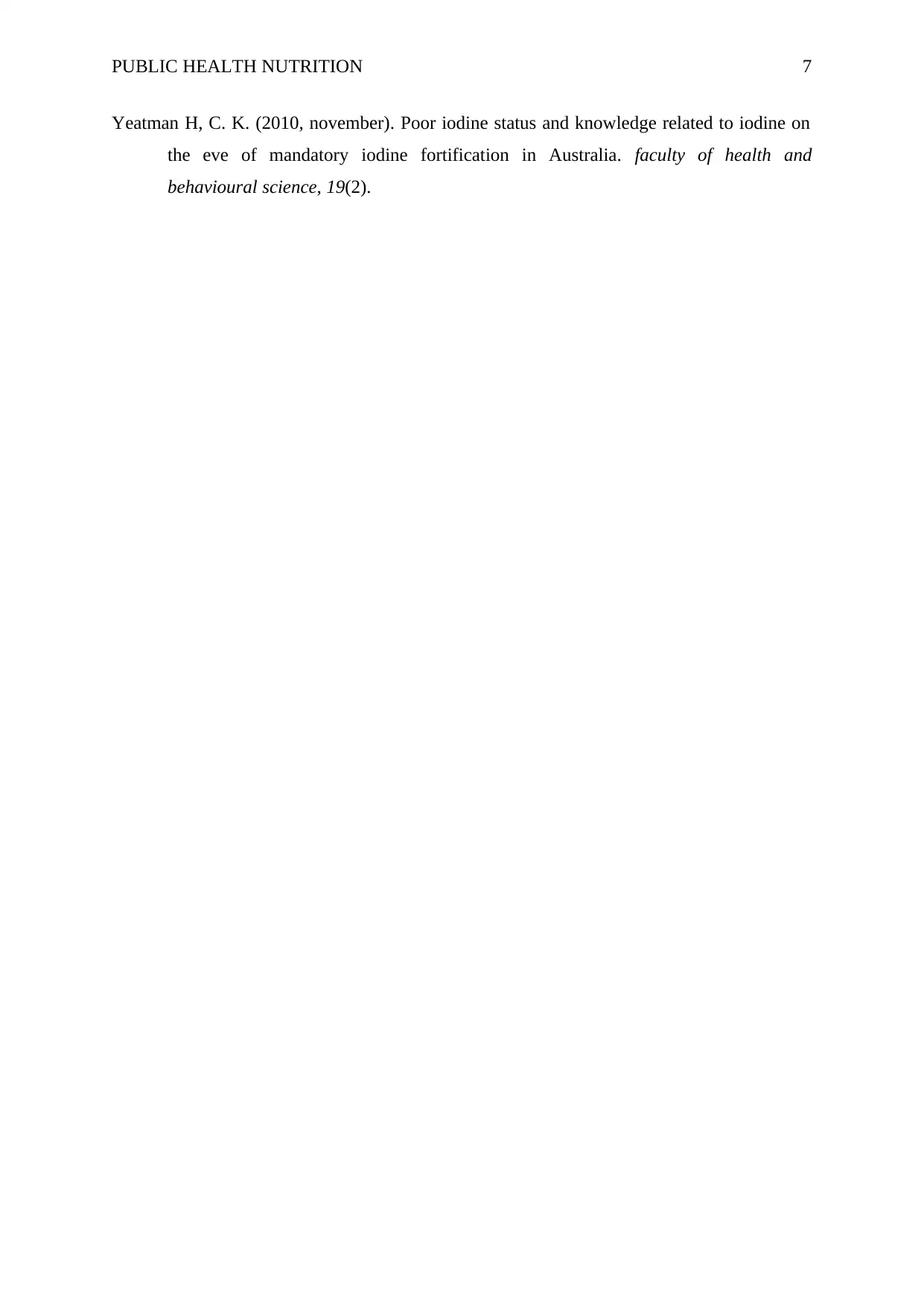
PUBLIC HEALTH NUTRITION 7
Yeatman H, C. K. (2010, november). Poor iodine status and knowledge related to iodine on
the eve of mandatory iodine fortification in Australia. faculty of health and
behavioural science, 19(2).
Yeatman H, C. K. (2010, november). Poor iodine status and knowledge related to iodine on
the eve of mandatory iodine fortification in Australia. faculty of health and
behavioural science, 19(2).
1 out of 8
Related Documents
Your All-in-One AI-Powered Toolkit for Academic Success.
+13062052269
info@desklib.com
Available 24*7 on WhatsApp / Email
![[object Object]](/_next/static/media/star-bottom.7253800d.svg)
Unlock your academic potential
Copyright © 2020–2025 A2Z Services. All Rights Reserved. Developed and managed by ZUCOL.





